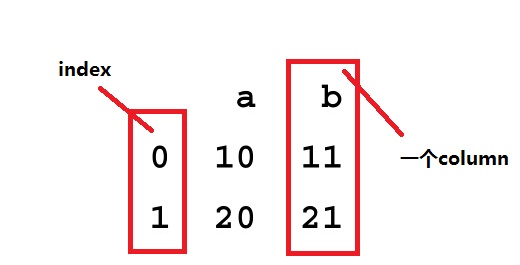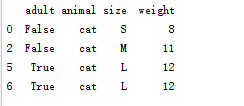Pandas入门(二)——DataFrame结构及常用操作
2017-05-11 11:32
579 查看
1. 介绍
DataFrame unifies two or more Series into a single data structure.Each Series then represents a named column of the DataFrame, and instead of each column having its own index, the DataFrame provides a single index and the data in all columns is aligned to themaster index of the DataFrame.
这段话的意思是,DataFrame提供的是一个类似表的结构,由多个Series组成,而Series在DataFrame中叫columns(理解有错请指出,(逃~

2. 相关操作
a.create
pd.DataFrame() 参数:
1、二维array;
2、Series 列表;
3、value为Series的字典;
a.1、二维array
import pandas as pd import numpy as np s1=np.array([1,2,3,4]) s2=np.array([5,6,7,8]) df=pd.DataFrame([s1,s2]) print df1
2
3
4
5
6
7
1
2
3
4
5
6
7

a.2、Series列表(效果与二维array相同)
import pandas as pd import numpy as np s1=pd.Series(np.array([1,2,3,4])) s2=pd.Series(np.array([5,6,7,8])) df=pd.DataFrame([s1,s2]) print df1
2
3
4
5
6
7
1
2
3
4
5
6
7

a.3、value为Series的字典结构;
import pandas as pd
import numpy as np
s1=pd.Series(np.array([1,2,3,4]))
s2=pd.Series(np.array([5,6,7,8]))
df=pd.DataFrame({"a":s1,"b":s2});
print df12
3
4
5
6
7
1
2
3
4
5
6
7

注:若创建使用的参数中,array、Series长度不一样时,对应index的value值若不存在则为NaN
b.属性
b.1 .columns :每个columns对应的keys
b.2 .shape:形状,(a,b),index长度为a,columns数为b
b.3 .index;.values:返回index列表;返回value二维array
b.4 .head();.tail();
c.if-then 操作
c.1使用.ix[]
df=pd.DataFrame({"A":[1,2,3,4],"B":[5,6,7,8],"C":[1,1,1,1]})
df.ix[df.A>1,'B']= -1
print df12
3
1
2
3

df.ix[条件,then操作区域]
c.2使用numpy.where
df=pd.DataFrame({"A":[1,2,3,4],"B":[5,6,7,8],"C":[1,1,1,1]})
df["then"]=np.where(df.A<3,1,0)
print df12
3
1
2
3

np.where(条件,then,else)
d.根据条件选择取DataFrame
d.1 直接取值df.[]
df=pd.DataFrame({"A":[1,2,3,4],"B":[5,6,7,8],"C":[1,1,1,1]})
df=df[df.A>=2]
print df12
3
1
2
3

d.2 使用.loc[]
df=pd.DataFrame({"A":[1,2,3,4],"B":[5,6,7,8],"C":[1,1,1,1]})
df=df.loc[df.A>2]
print df12
3
1
2
3
(还有很多种方法就不一一列举了)
e.Grouping
e.1groupby 形成group
df = pd.DataFrame({'animal': 'cat dog cat fish dog cat cat'.split(),
'size': list('SSMMMLL'),
'weight': [8, 10, 11, 1, 20, 12, 12],
'adult' : [False] * 5 + [True] * 2});
#列出动物中weight最大的对应size
group=df.groupby("animal").apply(lambda subf: subf['size'][subf['weight'].idxmax()])
print group12
3
4
5
6
7
1
2
3
4
5
6
7

e.2 使用get_group 取出其中一分组
df = pd.DataFrame({'animal': 'cat dog cat fish dog cat cat'.split(),
'size': list('SSMMMLL'),
'weight': [8, 10, 11, 1, 20, 12, 12],
'adult' : [False] * 5 + [True] * 2});
group=df.groupby("animal")
cat=group.get_group("cat")
print cat12
3
4
5
6
7
8

1
2
3
4
5
6
7
8

其他具体操作请参考CookBook
http://pandas.pydata.org/pandas-docs/stable/cookbook.html
相关文章推荐
- Pandas入门(二)——DataFrame结构及常用操作
- Pandas入门(二)——DataFrame结构及常用操作
- python:pandas模块中的DataFrame结构及常用操作
- C#入门篇6-1:字符串操作 char常用的函数
- DOS入门常用操作
- SQL Server 2000常用操作疑难21问,入门必备
- Linux入门——目录结构、Shell和几个常用命令的简介
- Pandas入门—Series和DataFrame
- matlab基本操作 关键字 特殊变量 常用命令 数据结构
- Python 数据处理库 pandas 入门教程基本操作
- vim常用操作入门
- R-dataframe常用操作
- pandas库中数据结构DataFrame的绘制函数
- Spark编程指南入门之Java篇四-常用Actions操作
- Linux命令-基本操作及文件操作常用命令--详解Linux入门到精通系列
- Linux常用操作命令——FireFly入门视频教程02
- Oracle常用操作——复制表结构
- Pandas常用操作
- [PY3]——内置数据结构(3)——字符串及其常用操作
- IntelliJ IDEA 入门常用操作
